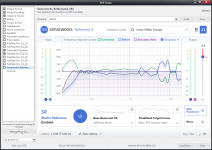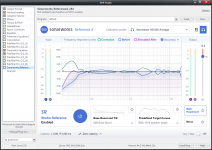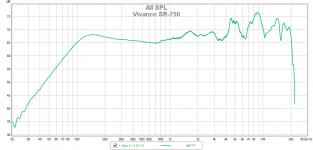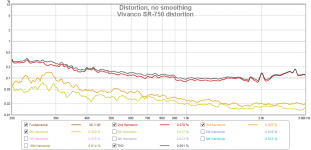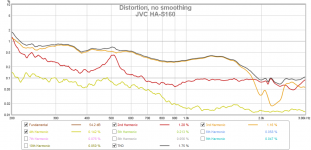I could hear the sine distortion too, but couldn't prove it with a Foobar test, which is ironic.
I could hear the sine distortion too, but couldn't prove it with a Foobar test, which is ironic.
Sorry, I can hear a voice coming from the long grass but can't see who's talking 😀
I can hear that tooi once hear a marketing tagline to the affect of "it's all the stuff you can't hear that makes a difference!"
My headphones are the SR80. I found this test of the SR80e which shows the peak Pano mentioned and I can hear something very much like it using tones Grado SR80e Review - RTINGS.com
I found this test of the SR80 showing a much different response, swinging wildly between 3 and 4kHz, I'm not hearing that at all Headphone Review - GRADO SR80
I found this test of the SR80 showing a much different response, swinging wildly between 3 and 4kHz, I'm not hearing that at all Headphone Review - GRADO SR80
Thanks. I'm going to have to get a real computer so I can fully participate in all the fun and games. That response doesn't look as bad. 10dB peak did seem a bit extreme
Last edited:
What does that even mean? What kind of control? Have you ever done the Foobar ABX test? You can easily load up two files that are readily identifiable, say two different songs, and go thru the procedure. You'll see that the results are exactly as they should be. No mystery.Both Jakob & I have always maintained that one essential element required to ensure a valid blind test was some sort of control which internally verified the test & therefore the results -
And Pavel has demonstrated a loop back measurement playing from the ABX plugin that shows exactly what it should. I will have time to do the same on Sunday. What other kinds of controls do you want? If you would actually do some of this work yourself, your criticisms might have more weight.
i've lost or overwrote the sine files i had and looking back through the thread i can't seem to find the link again?
wanted to test again with a new soundcard.
wanted to test again with a new soundcard.
Blind is the reality; ABX is merely one example of that.
For me personally, ABX is not reality. Never ever think that when you didn't pass an ABX then it means that the two sounds can safely considered as equal.
OTOH, sighted test is very biased. Ridiculously biased. People will claim things that do not exist.
But of course, there are people with good hearing that will be able to pick up small differences. ABX is a tool to find those people. When you spot them, listen to their opinions.
What does that even mean? What kind of control? Have you ever done the Foobar ABX test? You can easily load up two files that are readily identifiable, say two different songs, and go thru the procedure. You'll see that the results are exactly as they should be. No mystery.
And Pavel has demonstrated a loop back measurement playing from the ABX plugin that shows exactly what it should. I will have time to do the same on Sunday. What other kinds of controls do you want? If you would actually do some of this work yourself, your criticisms might have more weight.
Maybe he has not ability to install the plugin and to make the tests. And probably no interest to do so. Vague talks about controls indicate that his only interest is to criticize.
i've lost or overwrote the sine files i had and looking back through the thread i can't seem to find the link again?
wanted to test again with a new soundcard.
If you really wanted you would have done forum search. Diyaudio has efficient search engine.
http://pmacura.cz/sines.zip
http://pmacura.cz/sines44.zip
Hope the links are correct, I write by memory on a cell phone.
Thanks. I'm going to have to get a real computer so I can fully participate in all the fun and games. That response doesn't look as bad. 10dB peak did seem a bit extreme
You only need an external USB soundcard to your notebook, it would cost about $100. Most of these tests I am doing with a notebook. My notebook is much more powerful than my table PC 🙂
Re headphones - it is not easy to measure them for already mentioned reasons. I will repeat the links
Headphone Measurements Explained - Frequency Response Part One | InnerFidelity
Headphone Measurements Explained - Frequency Response Part Two | InnerFidelity
Headphone Measurement Procedures - Frequency Response | InnerFidelity
My attempt to measure headphones that I use for the tests is attached, it is a "free field like" measurement taken by a microphone placed several mm from headphones earpiece.
Distortion is quite low in middle frequencies.
Headphone Measurements Explained - Frequency Response Part One | InnerFidelity
Headphone Measurements Explained - Frequency Response Part Two | InnerFidelity
Headphone Measurement Procedures - Frequency Response | InnerFidelity
My attempt to measure headphones that I use for the tests is attached, it is a "free field like" measurement taken by a microphone placed several mm from headphones earpiece.
Distortion is quite low in middle frequencies.
Attachments
Last edited:
That's why I entered the thread when the sine wav tests showed that only one member (excluding PMA) showed that they couldn't hear an audible difference for what should be an audible difference - the sine wav
Both Jakob & I have always maintained that one essential element required to ensure a valid blind test was some sort of control which internally verified the test & therefore the results - the sine wav test was an after test kind of validation procedure which I thought exposed something from which a certain amount of learning could be extracted.
1
You assume that there must be an audible difference between the sine waves. That assumption can be wrong.
2
It depends on what you want to test, if you need extra control or not.
ABX is perfectly valid within its constraints. Do you want to test other things, use a different protocol.
1
You assume that there must be an audible difference between the sine waves. That assumption can be wrong.
.
I think that there should be (I tend to say must) an audible difference between the sine waves that I posted. If not, I would say it indicates to sound device not suitable for the test, or hearing loss, or impatience to find appropriate listening level for the sine test. If it was the first (bad sound device), then I would say the test cannot bring a meaningful result.
Distortion is quite low in middle frequencies.
Contrary to the Vivanco, e.g. cheap JVC HA-S160, $20, have much higher distortion. I think it is clear that with headphones like this the sine test most probably would not pass. So it makes a basic difference which equipment is used.
Attachments
You should understand that your ABX results were invalid, right? Why? Because after you did the ABX test which produced a null result (& people interpret this to mean no audible difference could be heard), you then did a sine wave test which showed that, actually it was your equipment that was at fault & the first interpretation of your ABX results were now incorrect - in fact your results were invalid. This sine wav post test exercise was in fact a way of checking the ABX test run by the people who participated & it revealed that most of the people returning their impressions or ABX results don't have a setup (or they themselves ) are not capable of hearing known audible differences incorporated in the Sine wav test.What does that even mean? What kind of control? Have you ever done the Foobar ABX test? You can easily load up two files that are readily identifiable, say two different songs, and go thru the procedure. You'll see that the results are exactly as they should be. No mystery.
So now the question is what about any future listening tests for audiblility by other people? Do we need to get them to run the sine wav test before they actually run the REAL listening test of the samples under test? If they fail to identify known audible differences, what does this tell you? If they then do an ABX audibility test their results should be disqualified from any consideration as they are not actually performing an audibility test - they have demonstrated their equipment (or themselves) are not capable of identifying the gross distortions in the sine wav files.
Using some hidden controls (of known audible differences) within the ABX test is an even more accurate way of identifying issues that might be affecting the test & ensuring the validity of the results. A reasonable control would be for the ABX software to randomly include some trials that are actually not A & B samples but rather A & A modified by some known audible volume change. The participant should be easily able to identify if X is A or A (modified). If they are not capable of doing this then the quality of the ABX results are in question.
So at the end of the ABX test, the software would identify which of the 16 (or more) trials were the hidden controls & the listening result for these hidden control trials examined to check for the user passing the audibility of these trials. If all were identified then the other results can be considered as valid. If none were identified then the other ABX trials are in question as to whether they can actually hear audible differences & if they (or their equipment) is suitable for doing audibility tests at this level.
This was all spelled out before on other threads.
As PMA & others have stated here - the problem is that there is a wide range of equipment & people doing this test without any pre-conditions or CONTROLS & therefore the results are of a similar unqualified nature. it's like asking people to evaluate the photographs from two different cameras but not knowing if they are looking at these pics on mobile phones, large screens, printouts on inkjet printers, laser printers, etc - the variety & unknown quality of the viewing process is part of the problem but there are other potential issues that should be resolved as far as possible
Ah, I see you are taking this up incorrectly it's not about the ABX plugin distorting the audio sample - it's about how to test perception in a way that is somewhat valid & the results therefore have some veracity.And Pavel has demonstrated a loop back measurement playing from the ABX plugin that shows exactly what it should. I will have time to do the same on Sunday. What other kinds of controls do you want? If you would actually do some of this work yourself, your criticisms might have more weight.
Last edited:
Hmm, are you saying that the distortion introduced into the sine wav should NOT be audible by most people on most equipment? Can you expand on this, please?1
You assume that there must be an audible difference between the sine waves. That assumption can be wrong.
Edit: I see PMA has already answered you
Right, so what are you testing with this test? What does the title of the thread signify "Can you tell original file from tube amp record?"2
It depends on what you want to test, if you need extra control or not.
ABX is perfectly valid within its constraints. Do you want to test other things, use a different protocol.
Is the question being asked - "does your equipment qualify for listening tests of this level"? OR "Do you qualify for listening tests of this level?" OR "Is ABX suitable for listening tests of this level?"
OR is it asking "Is audio passed through tube playback & recording process audibly different to the original?"
There is a heap of differences between these different questions being asked which determines the testing procedure that should be used
A Chromebook is not a notebook, it can't run any windows programmes.You only need an external USB soundcard to your notebook, it would cost about $100. Most of these tests I am doing with a notebook. My notebook is much more powerful than my table PC 🙂
- Home
- General Interest
- Everything Else
- Can you tell original file from tube amp record? - test
